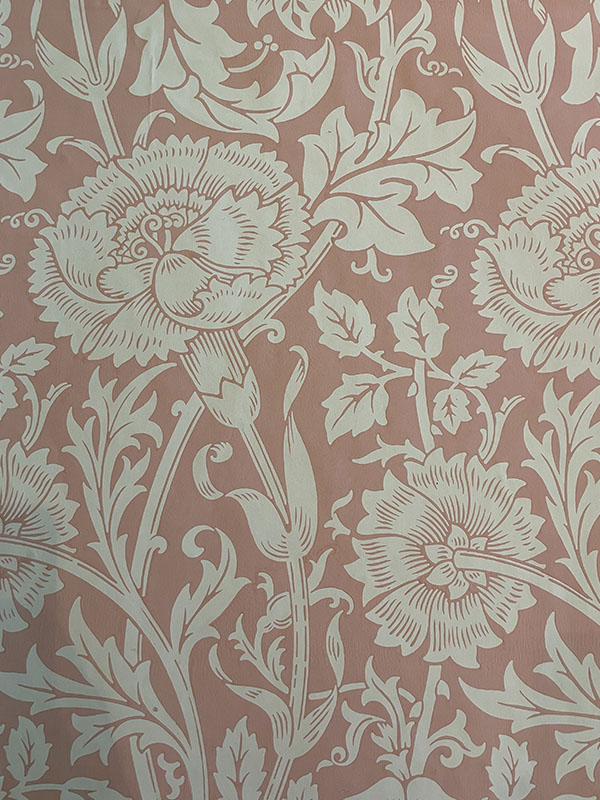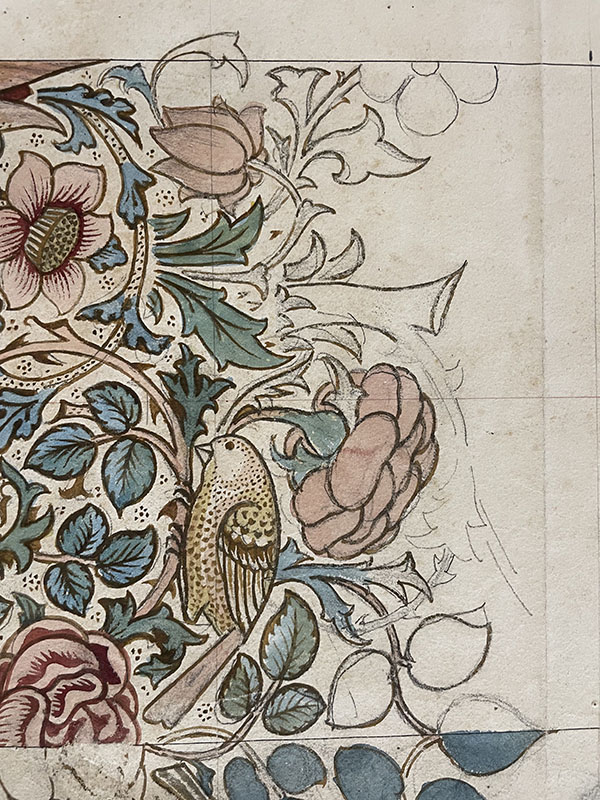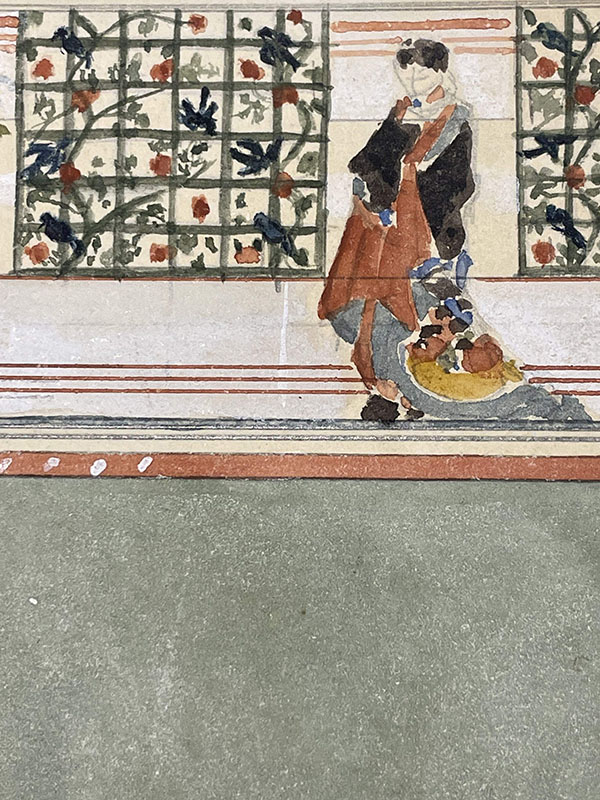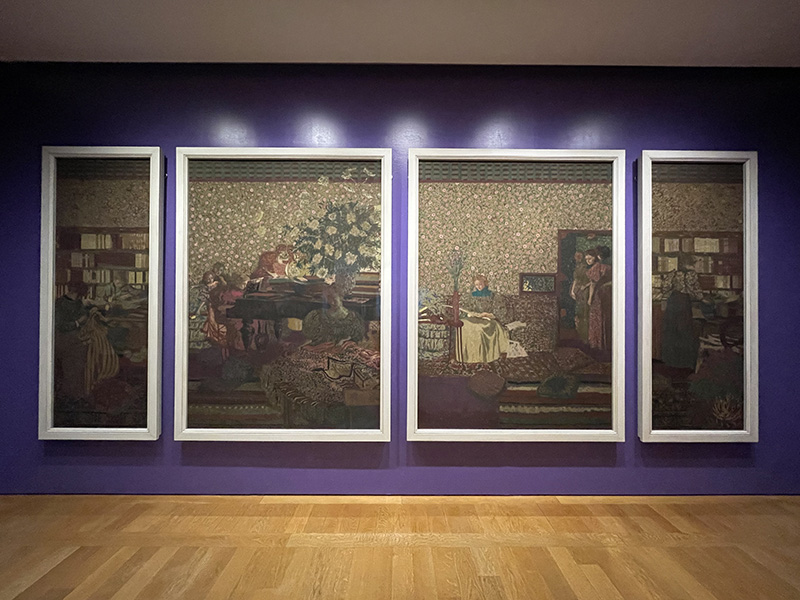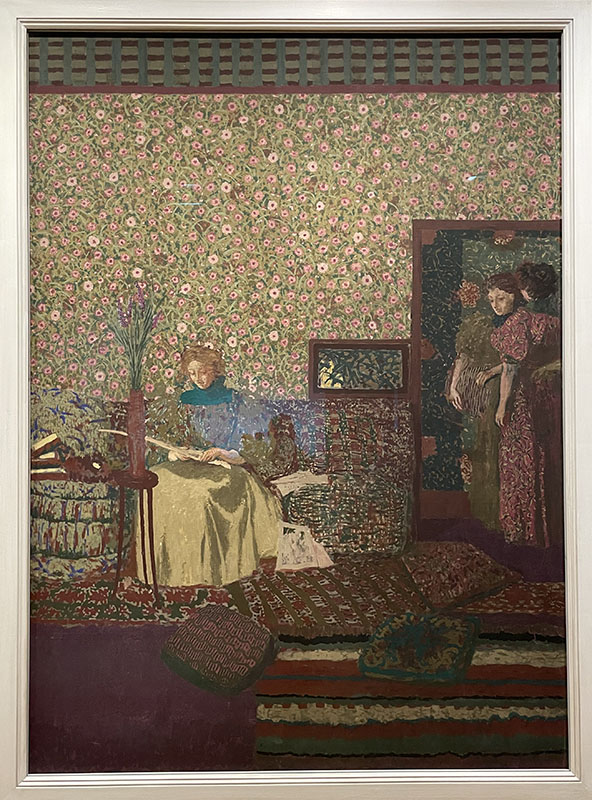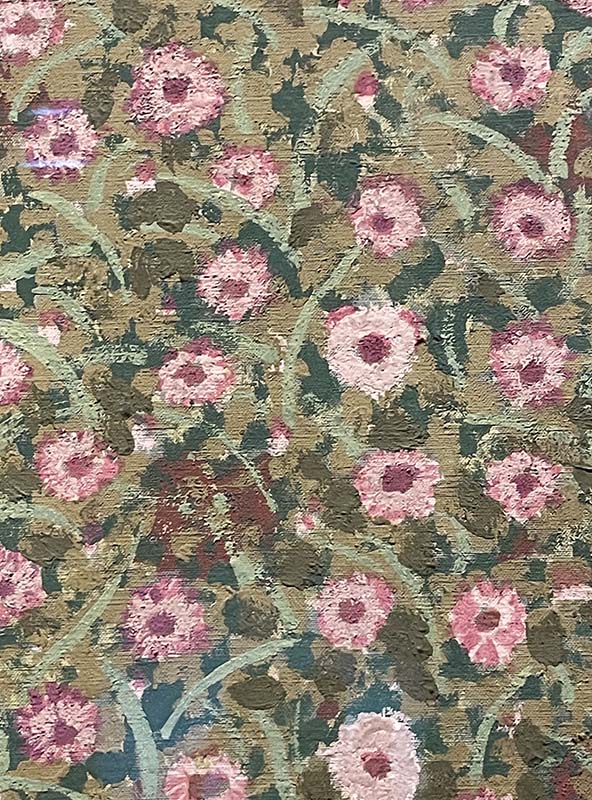Freedom, Growth, and Connection: Tendrils in 19th-Century Art and Design
by Emily Cox
With the generous support of the Marie Zimmermann Research Grant, I had the opportunity to visit collections and heritage houses related to my research on the tendril, a fin-de-siècle motif. My research, which I wrote as the second chapter of my dissertation Perverse Modernisms: 1889–1900, sets Edward Burne-Jones’s Briar Rose (1884–90) in dialogue with three contemporary interlocutors: Henri Bergson’s L’Essai sur les données immédiates de la conscience (Time and Free Will, 1889), William Morris’s Pink and Rose wallpaper (1890), and Alois Riegl’s Stilfragen: Grundlegungen zu einer Geschichte der Ornamentik (Problems of Style: Foundations for a History of Ornament, 1893).
The Trust’s Research Grant gave me the chance to travel to England and dive into Morris & Co. material related to the rose motif. At Morris’s Red House in Bexleyheath, I walked through the rose trellis garden that inspired Morris’s first rose wallpaper, Trellis (1864). At the Victoria & Albert Museum in London, I paged through reams of Morris & Co.’s sample books and was able to determine the different color sets for the Pink and Rose wallpaper. A closer look at the wallpaper samples helped me to see how Morris translated his design principle of “rational growth” into a decorative idiom: snipped buds spawn curling tendrils, diagonal lines shoot across the paper’s surface, protected by red-bruised thorns.
Morris & Co., 𝘗𝘪𝘯𝘬 𝘢𝘯𝘥 𝘙𝘰𝘴𝘦 wallpaper. Color print from woodblocks. England, c. 1890. Victoria & Albert Museum, London. Photo by author.
William Morris, watercolor sketch for 𝘙𝘰𝘴𝘦 𝘢𝘯𝘥 𝘛𝘶𝘭𝘪𝘱 wallpaper. England, 1883. Victoria & Albert Museum, London. Photo by author.
At Wightwick Manor in Wolverhampton, I saw Morris & Co.’s designs in situ and was able to compare the effect of Burne-Jones’s Briar Rose, which lines three of four walls in Buscot Park’s saloon, to the all-over patterning of Morris’s vegetal patterns. And finally, continuing to Paris, I was able to look closely at Édouard Vuillard’s Figures in an Interior, Intimacy (1896) at the Petit Palais. In this decorative panel the artist conjured a sense of decorative suffocation from the linear/organic play at work in Morris’s Pink and Rose wallpaper.
Édouard Vuillard, 𝘍𝘪𝘨𝘶𝘳𝘦𝘴 𝘪𝘯 𝘢𝘯 𝘐𝘯𝘵𝘦𝘳𝘪𝘰𝘳, 𝘐𝘯𝘵𝘪𝘮𝘢𝘤𝘺 (detail), 1896, Petit Palais, Paris. Photo by author.
Édouard Vuillard, 𝘍𝘪𝘨𝘶𝘳𝘦𝘴 𝘪𝘯 𝘢𝘯 𝘐𝘯𝘵𝘦𝘳𝘪𝘰𝘳, 𝘐𝘯𝘵𝘪𝘮𝘢𝘤𝘺 (detail), 1896, Petit Palais, Paris. Photo by author.
Each of these visits contributed to close looking, which is at the heart of my project. For this chapter, close looking and reading allowed me to think with the tendril across disciplines—to set paintings within a broader sweep of fin-de-siècle philosophy, decorative arts, and architecture. Opening with a comparison between Burne-Jones’s Briar Rose and Victor Horta’s Van Eetvelde House (1895), which conjures a vision of the Congo’s rubber trees within a bourgeois Brussels townhouse, my chapter argues that the tendril, as a decorative motif, indexes the feverish expansionism of the 1880s and 1890s. Horta’s Van Eetvelde House is concretely implicated in the violent colonialism of the fin de siècle. Its dynamic vines embody the connection between Belgium’s exploits in the Congo Free State and the artistic effervescence that its newfound, conflict-wrought wealth fueled back in Brussels. Burne-Jones’s Briar Rose has no such obvious one-to-one corollary, but his Briar Wood was worked and re-worked over the course of the “Scramble for Africa” (1884–85) with the cycle completed during the violent territory grabs which followed. Even in the absence of a direct visual quotation that lets us read art nouveau design as “style Congo,” I argue that the same fin-de-siècle anxiety—that feeling of being stuck, the urge to move without clear direction or available space—generates the free-wheeling spirals of Burne-Jones’s Briar Rose.
The tendril proposed three solutions to the stuck: freedom, growth, and connection, mapped onto the axes of time, space, and relation. Henri Bergson, William Morris, and Alois Riegl all turned to the free-flowing line as a means of clarifying and renewing their specific projects—a redefinition of time, a renewal of decorative art, a renovation of art historical methodology, respectively. But in each case, the curved line becomes the possibility of freedom even as it works on the knife-edge of collapse. In Time and Free Will, Bergson turns to the example of a rhythmical, curving line in order to conceptualize an idea of “time” that is uncoupled from space. Philosophy, he argues, must reimagine the form of time—free flowing, non-discrete, heterogenous—to have any chance of breaking out of determinist debates and positing man’s free will. In Morris’s Pink and Rose wallpaper (1890), we find that the rose’s overlapping stems create a thought pattern that excites the decorative imagination and creates the conditions for social regeneration. And in Riegl’s Problems of Style: Foundations for a History of Ornament, 1893, a survey of decorative tendrils across cultures and times supports Riegl’s project to write a ‘total’ history that purports to lay the foundations for a new—and crucially, Western—epoch in the history of ornament.
The tendril gives The Briar Rose its visual shock-value even as—or perhaps, precisely because—it threatens to overrun Burne-Jones’s canvases. I suggested that this two-pronged move—voracious growth that threatens suffocation—conjured the transnational system that drove Europe’s fin-de-siècle anxieties and preoccupations: capitalism. In the tendril, we find a figure whose core logic—boundless, frontierless, continuous growth—is shared with that violent, globalizing system. It represented the millenarian feeling that Europe was running out of space—that it was on the brink of collapse—and yet still seemed to promise its aversion. We could see Burne-Jones’s canvases as a subtle critique. Perhaps the curved line sought to break growth with growth: to hasten the collapse of imperialism from the inside by raising expansion to a fever-pitch. But the flip-side cuts: the new, we find, could only be imagined according to that same impulse.
Emily Cox is a PhD Student in History of Art at Yale University. Her research appeared in the June 2023 issue of Art History, the Journal of the Association for Art History.
About The Decorative Arts Trust Bulletin
Formerly known as the "blog,” the Bulletin features new research and scholarship, travelogues, book reviews, and museum and gallery exhibitions. The Bulletin complements The Magazine of the Decorative Arts Trust, our biannual members publication.
Click Images to Enlarge
Did you know that clicking on the images in Bulletin posts will allow you to get a closer look? Simply click on an image, and a larger version will open in a pop-up window.








